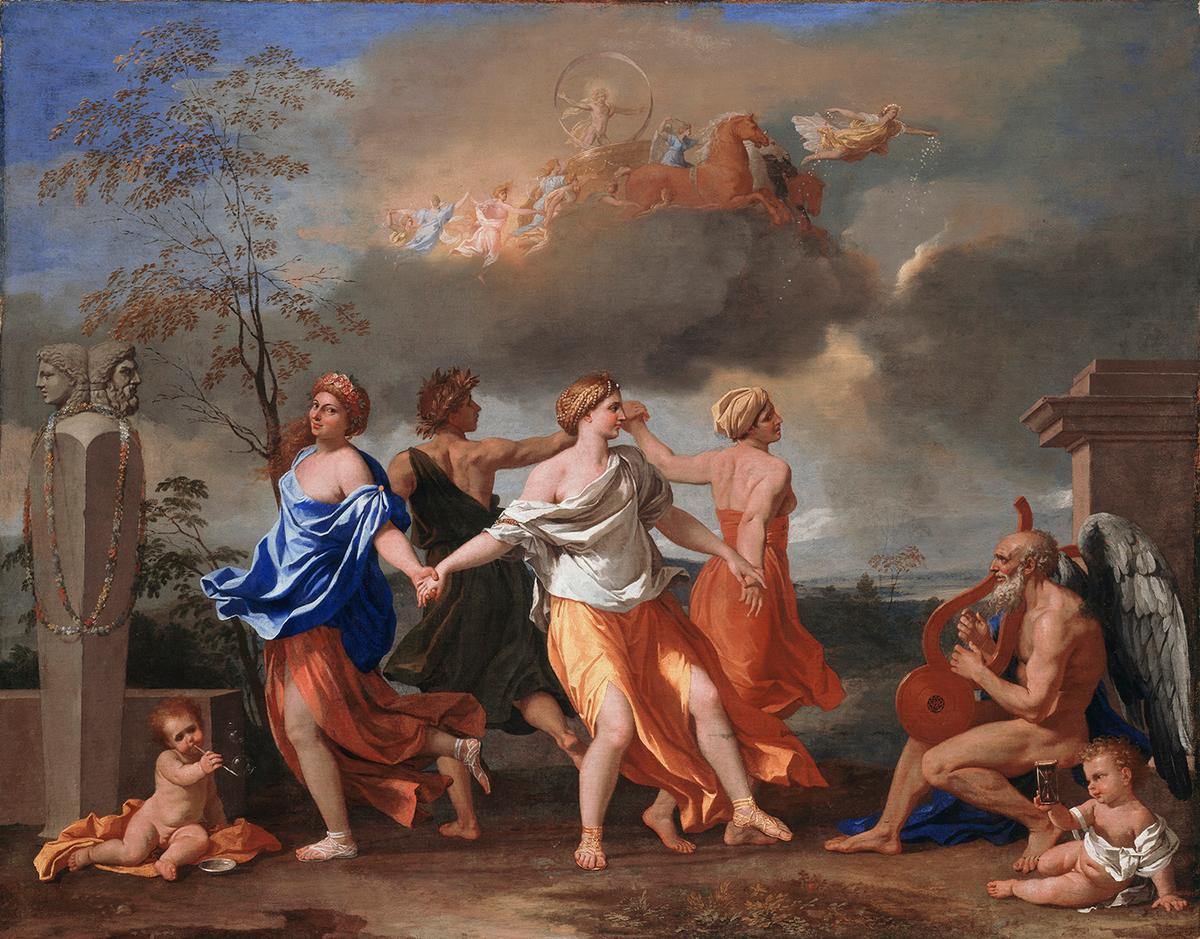‘A Dance to the Music of Time’

Poussin was a fervent admirer of the classical principles of ancient art; he aspired to attain their purity, nobility, formality, scholarliness, and structure in his precise compositions. He was especially inspired by dancing figures in ancient sculpture. It provided him with an elegant and sophisticated vehicle to innovatively explore movement in his history paintings. He did a series of dance-themed paintings, the most eminent being “A Dance to the Music of Time.” It was produced at the behest of Giulio Rospigliosi (later Pope Clement IX) and is now part of The Wallace Collection.
In “A Dance to the Music of Time,” the main figures are in eternal motion, yet Poussin is able to create a sense of otherworldly stillness with harmonious color and line. This is an allegorical painting set in a pastoral landscape, and the exact meaning is open to interpretation. The subject originates from an excerpt in “Les Dionysiaques” by Claude Boitet de Frauville that concerns the seasons and the gods Jupiter and Bacchus; the circular figures holding hands can be viewed as the personified seasons dancing, while winged Father Time on the right plays a lyre. A plinth on the left is topped by sculpted heads of both a young and an older Bacchus.
This painting is also symbolic of different states of the human condition, with the dancing figures rhythmically whirling perpetually through the cycle of life. These figures represent poverty, labor, wealth, and pleasure; if carried to excess, pleasure returns one to poverty.

The most prominently featured and lit of the four dancers are Wealth and Pleasure. Wealth, the lady in yellow, wears shot silk clothing (two or more colored threads producing an iridescent appearance) and pearls in her hair.
Pleasure is crowned by a garland of flowers and wears flowing robes, which are accentuated by her beguiling expression. There’s a putto (chubby male child) on either side of the canvas. One holds an hourglass and the other blows bubbles—both serving as reminders of the brevity of life. The vignette at the top of the canvas shows Aurora (the dawn) leading a procession across the morning sky. She’s followed by the sun god Apollo, riding his chariot, and the Hours, further supporting the sentiment of time passing.

‘La Camargo Dancing’
The art form of ballet reached its peak in France in about the mid-17th century. At first, it was performed primarily by aristocratic men at court and typically encompassed the celebration of ancient classical themes. King Louis XIV—also called the Sun King—was himself a skilled and dedicated dancer.
Gradually, women played a more important role in ballet. In the 18th century, one of the greatest ballet stars of this first generation of professional female leads was Marie de Camargo (1710–1770), who performed in the Paris Opéra Ballet. Camargo was renowned for her athleticism and technical brilliance that rivaled male dancers, and she extended the repertoire of the time with new steps. To enable her active footwork, she shortened the skirts of her costumes and may have been one of the first ballet dancers to wear slippers instead of heeled shoes. She was a fashion trendsetter from her shoes to her coiffures.
Camargo was a muse for the artist Nicolas Lancret (1690–1743), who created several paintings of her that were later turned into engravings. The most celebrated from this series is the first one that he created, “La Camargo Dancing.” It’s now part of the National Gallery of Art.

Lancret was a highly talented follower of Antoine Watteau and he, too, painted “fêtes galantes,” or small-sized works that show groups of elegant men and women beautifully dressed in a parkland setting. However, Lancret developed his own distinctive style, creating scenes that more directly referenced contemporary society, and used bolder and livelier colors. His work was popular and entered collections that included Versailles and Frederick the Great’s Sanssouci in Potsdam, where “La Camargo Dancing” first took up residence. He inspired subsequent artists including François Boucher, William Hogarth, and Thomas Gainsborough.
The composition of “La Camargo Dancing” features stylish spectators placed in an intricate “S”-curve design that accentuates the movement of the dancing couple performing a pas de deux. They dance to music played by instrumentalists who are partially concealed by trees on the left. Lancret had painted a fête galante genre scene, but it’s also a contemporary portrait.

‘The Wedding Dance’

A foil for decorative paintings of refined and codified dance can be found in the work of the 16th-century artist Pieter Bruegel the Elder (circa 1525–1569). He’s known as “Peasant Bruegel” for his complex, detailed, and unidealized depictions of everyday peasant Netherlandish life (in what’s today Belgium) that were based on direct observations. Concrete biographical details are scarce, but he was the most accomplished member of a multigenerational artistic family—his sons include the prominent artists Pieter Brueghel the Younger and Jan Brueghel the Elder—and his fame and influence spread through the distribution of prints after his works.

Scholarly analysis of “The Wedding Dance” is debated, much like many Bruegel works, revealing the complexity and originality of his oeuvre. There are multiple interpretations, from moral lessons to political stances. For the former, one could construe a didactic warning that loutish and dissipated behavior leads to sin.
Another reading is that it’s a rebuttal of the Catholic Spanish King’s oppression of Protestantism in their Netherlandish provinces. Many peasants practiced Protestantism, so Bruegel is perhaps refuting the royal powers by celebrating a type of merrymaking frowned on by the Catholicism of the day. Irrespective of contrasting interpretations, it’s agreed that this painting isn’t simply a recreation of a dancing scene from everyday life, but rather showcases the artist’s humor and wit, along with deeper meanings.
Each painting continues to “dance”—inspiring artists and delighting viewers.





